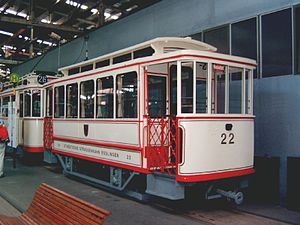Eßlingen am Neckar tram
| Eßlingen am Neckar tram | |||||||||||||||||||||||||||||||||||||||||||||||||||||||||||||||||||||||||||||||||||||||||||||||||||||||||||||||||||||
|---|---|---|---|---|---|---|---|---|---|---|---|---|---|---|---|---|---|---|---|---|---|---|---|---|---|---|---|---|---|---|---|---|---|---|---|---|---|---|---|---|---|---|---|---|---|---|---|---|---|---|---|---|---|---|---|---|---|---|---|---|---|---|---|---|---|---|---|---|---|---|---|---|---|---|---|---|---|---|---|---|---|---|---|---|---|---|---|---|---|---|---|---|---|---|---|---|---|---|---|---|---|---|---|---|---|---|---|---|---|---|---|---|---|---|---|---|---|
|
ESS sidecar 22 in the Stuttgart Tram World
| |||||||||||||||||||||||||||||||||||||||||||||||||||||||||||||||||||||||||||||||||||||||||||||||||||||||||||||||||||||
| Gauge : | 1000 mm ( meter gauge ) | ||||||||||||||||||||||||||||||||||||||||||||||||||||||||||||||||||||||||||||||||||||||||||||||||||||||||||||||||||||
| Power system : | 600 volts = | ||||||||||||||||||||||||||||||||||||||||||||||||||||||||||||||||||||||||||||||||||||||||||||||||||||||||||||||||||||
|
|||||||||||||||||||||||||||||||||||||||||||||||||||||||||||||||||||||||||||||||||||||||||||||||||||||||||||||||||||||
The tram Eßlingen am Neckar was a meter-gauge tram in the city of Eßlingen am Neckar (today Esslingen am Neckar). It existed from 1912 to 1944 and provided for the inner-city development as well as the connection with the neighboring state capital Stuttgart . The tram was replaced by the trolleybus Esslingen am Neckar, which still operates today . The operating transport company was the Eßlinger Städtische Straßenbahn (ESS), this company has been operating as the Städtischer Verkehrsbetrieb Esslingen am Neckar (SVE) since the switch to trolleybuses .
history
After Eßlingen and its suburbs in the densely populated Neckar Valley had been connected to the railway network by the Filstalbahn since 1846 , increasing industrialization around the turn of the century made an additional means of transport necessary for local traffic. After construction work began on November 16, 1911 with the laying of the foundation stone for the carriage hall in Oberesslinger Strasse, on May 24, 1912 a tram line, electrified from the start, from Obertürkheim station - Obertürkheim was incorporated to Stuttgart in 1922 - via Mettingen and Eßlingen station to Obereßlingen go into operation. This so-called through line , which was 7.5 kilometers long, was followed on July 2, 1912 by a supplementary route called a city line . The latter measured 2.1 kilometers and, as a ring line, connected Esslingen's old town on two sides with the train station. It led from Bahnhofplatz via Eisenbahnstraße (today Fleischmannstraße), Bahnhofstraße, Abt-Fulrad-Straße, Marktplatz, Rathausplatz, Ritterstraße, Küferstraße, Ottilienstraße (today Richard-Hirschmann-Straße), Obertorstraße and Charlottenplatz back to the train station, the fare was five pfennigs .
The Stuttgarter Straßenbahnen AG (SSB) was entrusted with the operation of both lines from the start , the legal basis for this was a joint shareholder agreement . The Esslingen tram, however, had its own vehicles, they were painted cream-red. Already during the year 1915, the city had to line due to war-related material shortages again be set, it was not reopened after the war.
On February 14, 1919, a new line of the Stuttgart suburban trams , which were also operated by the SSB, went into operation between Hedelfingen and Obertürkheim. Hedelfingen - which was incorporated into Stuttgart in 1922 - had already had a tram connection to Stuttgart since 1910, so the new line closed the gap between the Stuttgart and Esslingen tram networks. Due to the route in Hedelfingen at that time, however, no through traffic could yet be introduced. The tram cars coming from Eßlingen drove to Hedelfingen Schule, there you could transfer to the cars coming from Hedelfingen town hall towards Stuttgart. It was not until November 21, 1919 that lines 16 and 19 ran through to Obertürkheim, where there was a connection to and from Obereßlingen. Continuous operation was finally started on May 3, 1920. From then on, the two SSB / ESS joint lines 19 (Obereßlingen – Hedelfingen– Wangen - Untertürkheim ) and 26 (Obereßlingen– Schloßplatz ) as well as the pure ESS line 27 (Obereßlingen – Eßlingen station) operated. After the SSB line network reform of December 1, 1930, only lines 26 and 27 remained on the ESS section, from now on line 19 only shuttled between Obertürkheim and Hedelfingen, it finally disappeared completely on April 15, 1931.
Another line change on November 20, 1939, when the SSB had to extend the existing twelve-minute cycle to a fifteen-minute cycle due to the war, resulted in the renewed separation of the two networks. The reason for this: the evasion of the continuously single-track Esslinger tram was designed for the rigid twelve-minute operation, which was condensed into a six-minute operation between Eßlingen and Obereßlingen.
The commissioning of the trolleybus on July 10, 1944 finally sealed the end of the Eßlinger tram, its last day of operation was July 7, 1944. However, the trains of the Eßlingen – Nellingen – Denkendorf tram , which opened in 1926, ran from the Esslingen station to Denkendorf until 1978 or Neuhausen on the Filder . Until 1951 they turned in Eßlingen by means of a block loop that led clockwise from Bahnhofplatz, via Friedrichstraße (today Berliner Straße), local road no. 18, Bahnhofstraße and Eisenbahnstraße back to Bahnhofplatz. Most of the END trains ran on the ESS infrastructure, only the short cross-connection between the through line and the city line belonged to the END.
literature
- Gottfried Bauer, Ulrich Theurer, Claude Jeanmaire: Trams around Stuttgart . Verlag Eisenbahn, Villigen / Switzerland 1984, ISBN 3-85649-047-7 .





